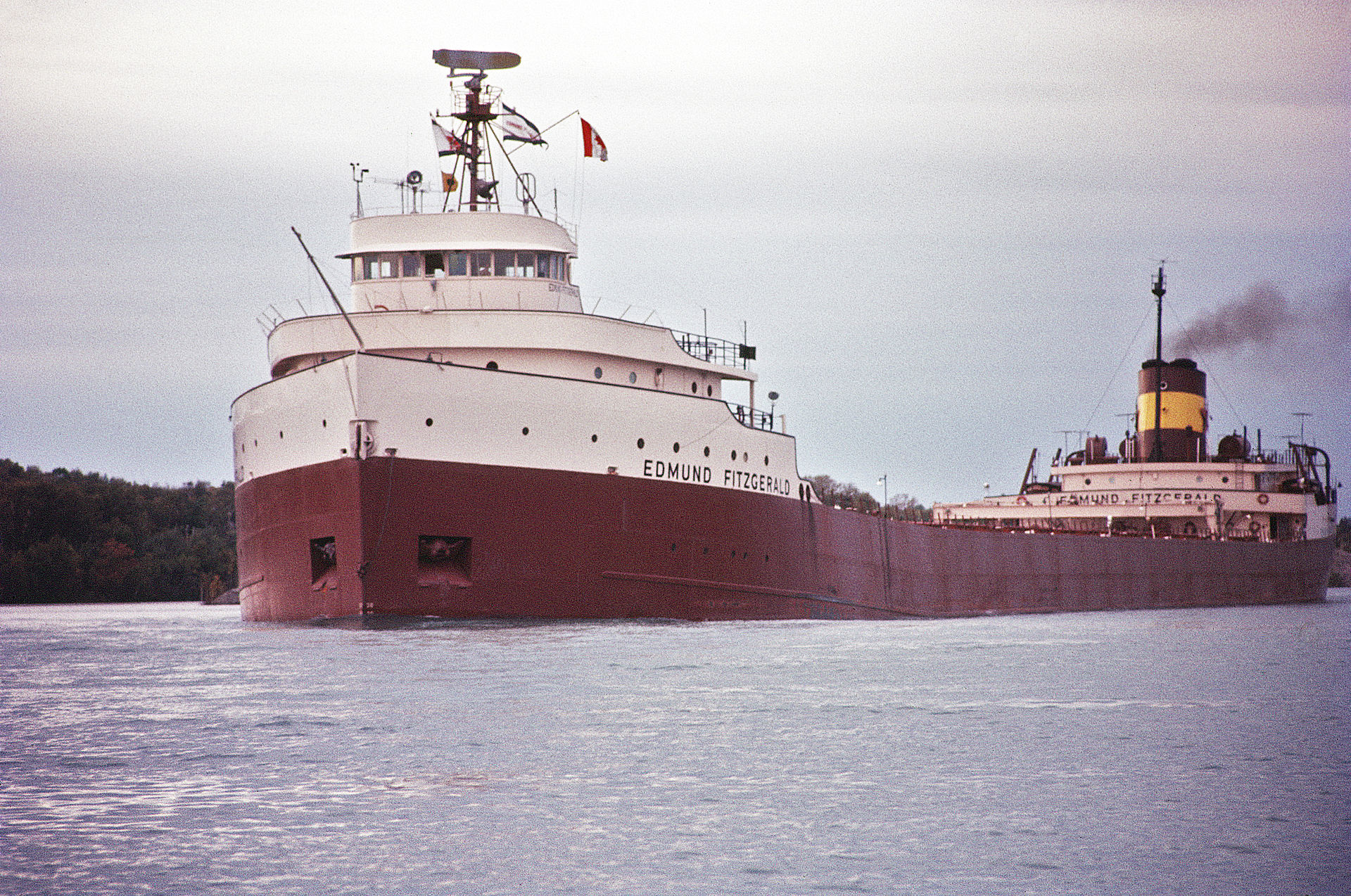Metallurgy in the Wake of the Edmund Fitzgerald

The SS Edmund Fitzgerald underway. Photo by Winston Brown.
Forty years ago, the SS Edmund Fitzgerald, the “Pride of the American Flag,” left Superior, Wisconsin at 2:15 p.m. en route to a steel mill on Zug Island near Detroit, Michigan. With a cargo of 26,116 long tons of taconite ore pellets, the ship was the largest vessel of its kind to sail the Great Lakes. Its captain was a 40-year veteran. Twelve hours later, during a severe winter storm with winds of 52 knots and rogue waves up to 35 feet high, the “Mighty Fitz” sank at approximately 7:10 p.m. No distress signal was ever received. All 29 of her crew were lost. Forty years later, the sinking of the Edmund Fitzgerald remains the deadliest shipwreck — and greatest mystery — on the Great Lakes.
Speculations and Lessons Learned
Tragedies like the sinking of the Fitzgerald teach us a great deal about how metals and their applications interact with the harsh, sometimes violent conditions of the open sea.
During WW2, U.S. shipbuilders struggled to understand why the hulls of their mighty Liberty vessels were literally cracking — some splitting in half. The answers were found in both metallurgy and manufacturing. Metallurgists learned that the hull materials in use at the time could not withstand the stresses encountered at sea in very cold climates. Though these waters had been in active use for decades, the change from riveting to welding revealed a fundamental weakness in the hull materials—a transition from tough to brittle at low temperatures. This flaw had previously been countered by the riveted assembly method. When small cracks formed, they were arrested by the rivet holes and did not propagate to any significant degree. When welding replaced riveting, however, no features were available to prevent the crack from spreading. There were nearly 1,500 occurrences, 12 of which resulted in ships breaking completely in half. The realization that metal properties can be temperature-dependent resulted in both new test methods and new alloys to reduce the risk mariners face in cold climate shipping.
For the SS Edmund Fitzgerald, the exact cause of the wreck is still undetermined to this day. However, based on clues resting at the bottom of Lake Superior, theories are abundant.
One theory speculates that a couple of the Fitzgerald's giant metal cargo hatches near the center of the vessel had weakened and caved inward from the force of the violent waves, allowing massive amounts of water to swamp the cargo hold, overwhelming its pumps and sinking the ship in a matter of minutes. Although it is was never substantiated, this hatch theory — like the Liberty failures — forced shipbuilders to ask, “How do we make vessels stronger?”
One of the potential means of improving a ship’s strength is to incorporate more forged components. Forging, by nature, is stronger and more durable than casting or welding. Thanks to a variety of engineered materials, expanded facilities and new technologies, marine designers now have more options for forged parts than ever before. We asked Pat Nowak, Process Metallurgist for Scot Forge, what the best applications of forging are in marine environments:
“For making new ships or repairing existing ones, manufacturers can forge everything from ABS shafts/bars to hollow tubing, piston rings, gears, support bearings and a wide array of custom components.”
Same Waters. Better Metals.
“Today we work with stronger and lighter metals that have dramatically changed how we approach maritime applications,” Nowak explains. “We have access to new cutting-edge alloys like duplex and super duplex stainless steels, bronze, nickel and aluminum alloys that can better handle corrosive and extreme environments. In fact, many of these forging materials are so strong and corrosion-resistant that we do not even need to paint them to protect them from the elements.”
New Super Duplex Alloys
A super duplex alloy is the most corrosion-resistant, as measured by Pitting Resistance Equivalent Number (PREN). Super duplex materials have a PREN greater than 40.
Bronze Alloys
Bronze alloys are extremely popular today for their looks, strength and resistance to corrosion. While they have always been used to make bells, mirrors, weapons and sculptures, they are more prevalent today because the way they are engineered and processed, making them a more attractive option for design engineers.
High Yield Strength Materials
Today, we also have access to high yield strength (HY) materials that are easier to weld yet ideal for applications that require toughness. They are often used on naval vessels and in other military applications. These alloys come in three grades: HY-80, HY-100 and HY-130, and are designed for low temperatures.
Stronger Metals. Smarter Tools.
Not only has the quality of engineered metals evolved over the past 40 years, but so have the tools to forge them. Today, world-class manufactures like Scot Forge use 3D computer modeling and forging simulation software to expanded the possibilities what parts can be forged.
As a result, today’s marine engineers are able to design vessels that are bigger, lighter, faster, more fuel-efficient and — most important of all — safer for the crews who sail them.